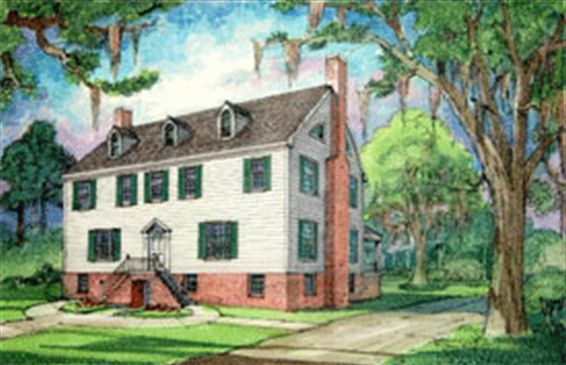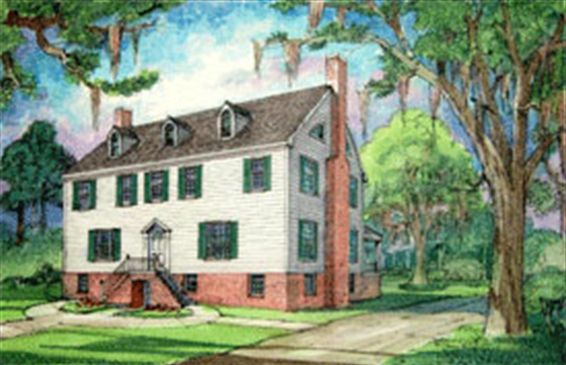Col. John GRAHAM [7936]
- Baptised: 11 Feb 1732/33, Dunbar Scotland
- Marriage (1): Frances CROOKE [7938]
- Died: 11 Feb 1791, St Lawrence House Canterbury KEN aged 58
 Another name for John was John Graham PYOT. Another name for John was John Graham PYOT.

 General Notes: General Notes:
John Graham & Co Ltd.
John Graham personified the creative tension. In 1753, he and his younger brother James left London for Savannah (Georgia) on the promise of financial support and political favours from the metropolitan centre. The brothers were already part of the London commercial world where Graham was "known to some of your Lordship's" on the Board of Trade according to Gov Ellis. Sons of a Presbyterian minister outside Edinburgh, they took the opportunity to change their name from the flat sounding Pyot to the more recognisable Graham. Early on, progress was measured in painfully small steps. John Graham backed a merchant in the new community of Sunbury only to have the Englishman go bankrupt and flee to Williamsburg. He staked a Scotsman from Jamaica to plantation tools and enslaved people only to watch him fail. He purchased 10 slaves on St Kitts for his mother-in-law, in essence taking the commission on the transaction rather than risking a free sale in Savannah. He pushed his way far enough into the Carolina deerskin trade that the governor named him Clerk of accounts and Indian commissary for the Colony, but again the volume of deer skins crossing the wharfs at Savannah was negligible. He purchased choice tracts of undeveloped land with a remarkably large loan from the Coutts brothers of London and Edinburgh. Graham failed to meet the payments but, again connections prove more powerful than the financial realities of frontier Georgia. Dr Fothergill, a philanthropist, plant collector, Quaker, and backer of Benjamin Franklin, assumed the payments and extended Graham the privilege of renting the land until he could buy back.
In 1762 John Graham hammered out a partnership with an influential trader in deer skins, Lachlan McGillivray, a Scot from the trustee, and John Clark, a prominent factor in London, also a Scot. Although a leading player in the Carolina rice trade, Clark sensed new opportunities in deer skins and willingly sold three quarters of the partnership to the Graham brothers and McGillivray as the price of gaining a substantial foothold in the business while reducing risk. Four years later, John's brother James married the daughter of the Indian superintendent for the southern department and moved to London to coordinate a booming commerce a position made all the more pivotal by the lucrative contracts his father-in-law deftly sent his way. In Savannah the operative firm was John Graham & Co, in London, McGillivray, Graham, Clark. Like most of his peers involved in deer skins John Graham had a regional view of development, he invested heavily in land in Florida to take advantage of the boom in indigo and assiduously cultivated the governor James Grant, a fellow Scot. He used his friendship with the mayor of Lancaster, England, to break into the African slave trade and relied on his relationship with Locke and McGillivray and Andrew Maclean of Augusta to develop an extensive network of trade in Indian territory.
John Graham did not put down roots in Georgia as a permanent settler his ambition was to become an absentee owner in Britain as did many of the West Indian sugar barons.
Ref: On the Rim of the Caribbean: Colonial Georgia and the British Atlantic World - Paul M Pressly
 Research Notes: Research Notes:
They had 17 children.
Images courtesy J Mayne 2017.

 Other Records Other Records

1. John Graham born John Graham Pyot: By Jenny Mayne family genealogist, 2017, Precis of a Lecture given to the Riccarton Branch of the NZSOG.
FINDING COLONEL GRAHAM
Col. Graham was a mystery for many years. He wasn't a Colonel in the Army and he wasn't a Graham! John Graham was baptised at Dunbar, East Lothian, Scotland on 11 February 1733 as John Graham Pyot son of Rev. Alexander Pyot, Minister of the Parish. His education was possibly a law office because when just 18, he was appointed Bursar of Philosophy at Edinburgh University. He left Scotland for Georgia, North America in 1753 with his 16 year old brother James. In 1755, he married Frances Crooke recently arrived from St Kitts. John traded as a merchant in Johnson Square, Savannah and started buying properties. By 1774 he owned about 15,000 acres. He bought Kew and Richmond Plantations, a barque Inverness used for trading purposes and the Coleraine and Monteith Plantations, plus a commodious house in Bull Street, Savannah.
James Habersham a friend and neighbour wrote about Graham's house where, "staff consisted of coachman, hairdresser, tailor, 2 waiting boys, 2 children's women, three cooks, steward, groom, three washerwomen, midwife, a couple of house wenches." In 1757 Graham received his first official position as Commissary and Clerk of Accounts. Over the next 20 years he was elected to Georgia General Assembly, the King's Council, a Justice of the Peace, a Receiver General to sales of Indian lands, commissioned as Lieutenant Governor, made a Magistrate, a Superintendent for Indian Affairs in Mississippi Region and a Comptroller of Customs in Jamaica.
Mulberry Grove 1774
The jewel in the crown for John and Frances was their purchase of the Mulberry Grove Plantation on the Savannah River. They built a fine plantation house, orchard and garden and established rice fields. At the outbreak of the American Revolution, Lieutenant Governor John Graham was the second largest land owner. He valued his slaves on their occupations and noted in his schedule of personal losses: 262 negro slaves consisting of, "8 House carpenters, 5 Coopers, 4 Drivers, 4 Gardeners, 2 Blacksmiths, one Bricklayer, one Taylor, 14 Sawyers, 10 Carters, one Coachman, 2 Grooms, one Hairdresser, 2 Cooks, 3 Footmen, 14 Women, 43 Teamsters and Ploughmen, 190 Field slaves." He wrote to Governor James Grant of East Florida, saying he had purchased "two fine young men with wives and families for £320 who were capable of management of a plantation themselves".
He was a Loyalist or Tory, backing British rule along with many in Savannah, the Tory stronghold 'par excellence'. When revolution broke out his life changed irrevocably. In January 1776 he and Governor Wright were arrested, but paroled the next day. He was tipped off they were to be arrested again. They hid until they could escape by canoe to HMS Scarborough. When onboard he negotiated to be allowed to take his family to safety in England, "I was at great expense obliged to freight a vessel for that purpose." On 13 May 1776 he was permitted to leave the province with his "family of twelve (exclusive of servants), his wife, ten children a sister and niece, but could not take any of his property." Before leaving he tried to transfer ownership of Mulberry Grove to his wife. However, the deed was declared null and void by the Act of Confiscation passed by the Georgia Assembly.
On arrival in England he began writing Memorials asking for compensation for his losses. His wife Frances also appeared at Court in London pleading unsuccessfully for ownership of Mulberry Grove. The Crown awarded him a salary of £500 per annum for his position as Lieutenant Governor. He returned to Georgia with his four eldest sons in June 1779 and saw Count D'Estaing's siege of Savannah when again he hid in a tent with Governor Wright. He went to retrieve documents he had buried in an iron chest but they were perished by damp. He was again forced to evacuate Savannah and later Charleston, and with other loyalists moved to a safe haven in East Florida. He walked down the Old Kings Road to Flagler County with his four sons, his army of 200 slaves, livestock, farm equipment and personal belongings. On a grant of 20,000 acres he set up three rice plantations which he left in charge of an overseer and returned to England for health reasons. He was part owner of Telfair Rice Company at Dover and appointed joint claims commissioner in London.
In 1784, England ceded Florida to Spain creating another loss for which Graham eventually received £1000 compensation. Today this is a conservation park called Graham's Swamp. John Graham died at St Lawrence House near Canterbury, Kent on 11 February 1791, of a broken leg. His comprehensive claims for £70,000 are detailed and thorough. In his last will he names only one of his twelve children "My youngest child and constant little companion for many years, Charlotte Cunningham Graham." Charlotte is Peter's great great grandmother who married Rev Robert Mayne in 1803.
J Mayne 2017

John married Frances CROOKE [7938] [MRIN: 2674], daughter of Clement CROOKE of St Kitts [11457] and Heriot CUNNINGHAM [11434]. (Frances CROOKE [7938] was born circa 1740 in St Kitts West Indies and died in 1808 in St Lawrence House Canterbury KEN.)
|


 Another name for John was John Graham PYOT.
Another name for John was John Graham PYOT.